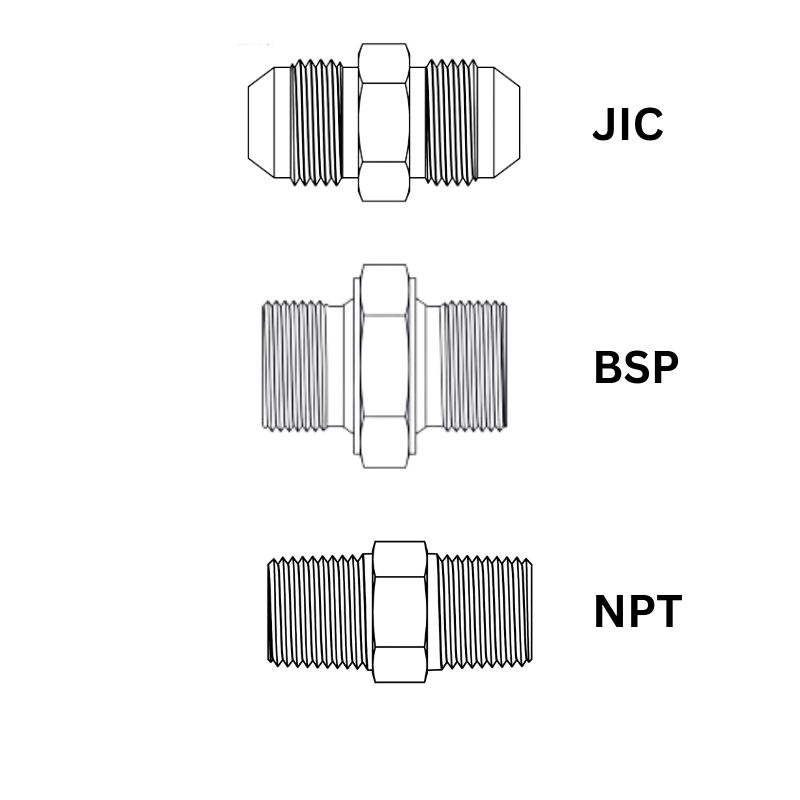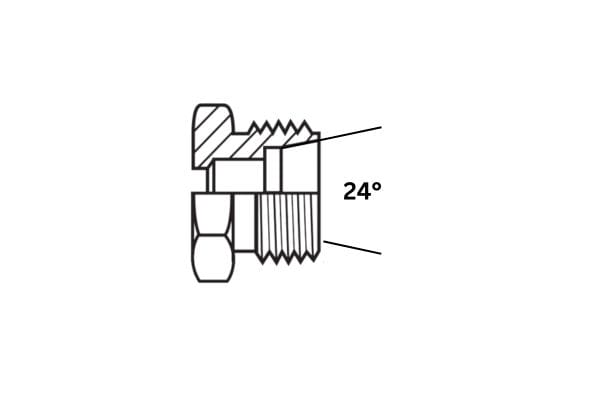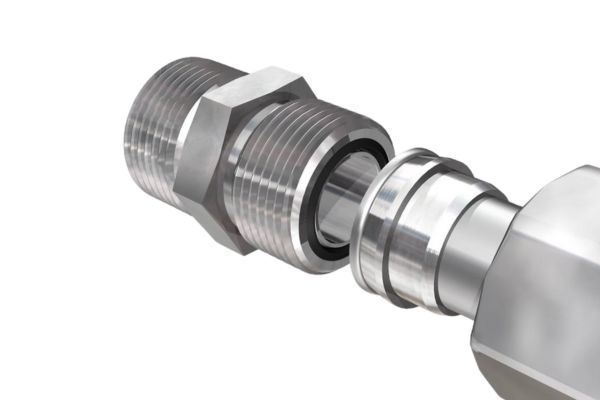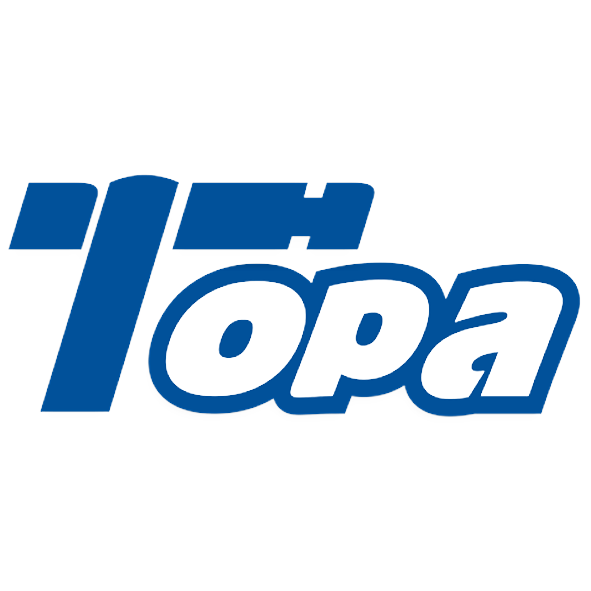Using the wrong hydraulic fitting causes leaks and system failure. This creates dangerous work environments, leads to expensive equipment downtime, and wastes valuable hydraulic fluid.
This glossary defines crucial hydraulic fitting terms from A to M. It clarifies the function and application of everything from Adapters and AN fittings to JIC and Metric threads, ensuring you select the right component every time.

The world of hydraulic fittings is filled with acronyms and standards that can be confusing. A JIC fitting looks similar to an AN fitting, but they are not always interchangeable. A BSPP thread requires a seal, while a BSPT thread does not. Making the wrong choice can be the difference between a reliable, leak-free connection and a constant maintenance headache.
Adapter to BSPP?
A pump has a metric port, but the hose assembly has a JIC fitting. This mismatch stops the assembly dead in its tracks, wasting time and requiring an urgent search for the right part.
An adapter connects two components with different thread sizes or types. BSPP is a common parallel thread standard that requires a bonded seal or O-ring to create a leak-proof connection against a smooth face.
Connecting Dissimilar Threads
In a perfect world, every component in a hydraulic system would have the same port type. In reality, this is never the case. We frequently see pumps from Europe with metric or BSPP ports that need to connect to hoses using American JIC or ORFS fittings. This is where adapters are essential.
- Adapter: A fitting that has different connection types on each end. Its sole purpose is to “adapt” one thread style or size to another. For example, an adapter could have a male BSPP thread on one end and a female JIC flare on the other. They are problem-solvers that allow otherwise incompatible components to be connected.
- AN Fitting: This stands for Army-Navy. It is a flare fitting with a 37° seating angle, originally designed for military and aerospace applications. AN fittings are made to extremely high tolerances for maximum reliability. While they look identical to industrial JIC fittings, their thread class and manufacturing standards are much more stringent. You can use a high-quality AN fitting in a JIC application, but you should never use a standard JIC fitting in a true AN application.
- BSPP (British StandardPipe Parallel): This is a parallel thread form, also known as a “G” thread under ISO 228-1. Because the male and female threads are parallel, they do not create a seal by themselves. The seal is made by compressing a soft seal between the male fitting and a smooth face on the female port. The most common method we supply is a “bonded seal,” which is a metal washer with a vulcanized rubber ring on its inner diameter. This provides an excellent, reliable seal against the port face.
Bulkhead to Compression Fitting?
A hose needs to pass through a machine panel, but the connection is flimsy. The vibration from the machine causes the fitting to loosen, creating a dangerous leak point inside the enclosure.
A bulkhead fitting is designed to mount securely through a panel, providing a fixed connection point. A compression fitting creates a seal by squeezing a ferrule onto a tube, a common method in instrumentation.
!A bulkhead fitting securely mounted through a steel plate, showing the locknut on the backside.
Mounting and Sealing Methods
Proper mounting and sealing are at the core of a reliable hydraulic system. The choice of fitting often depends on the physical layout of the machine and the type of conduit being used, whether it’s flexible hose or rigid tubing.
- Bulkhead Fitting: This is not a thread type, but a style of fitting body. A bulkhead fitting has a longer body with a locknut. This design allows it to pass through a hole in a panel or bracket, with the locknut tightened on the other side to create a rigid, fixed-point connection. It’s the standard solution for routing a fluid line through a machine wall or operator’s cab, preventing chaffing and stress on the hose. We see them used extensively on mobile equipment.
- Captive Seal: This is a feature of some fittings, particularly BSPP, where the O-ring or bonded seal is held in a special groove on the male fitting. This is a significant advantage for maintenance and assembly because the seal cannot be dropped or lost. It stays “captive” on the fitting, making installation in tight spaces much easier and more reliable.
- Code 61 / Code 62: These are standards for four-bolt flange fittings (defined by SAE J518). They are a very common choice for connecting larger hose sizes (typically 1/2″ and up) directly to pumps and motors.
- Code 61: Standard duty series, rated for pressures up to 3000-5000 PSI depending on size.
- Code 62: Heavy-duty series with a larger flange head and bolt pattern, rated for 6000 PSI across all sizes.
- Compression Fitting: This type of fitting seals by compressing a ring (called a ferrule or “olive”) onto the outside of a metal tube. It’s a non-welded solution often used in lower-pressure hydraulic systems, pneumatics, and instrumentation lines. The most robust version of this concept is the “bite-type” fitting.
DIN Fitting to Elastomeric Seal?
A connection on equipment from Germany is leaking. The thread looks metric, but a standard metric fitting does not seat correctly, leading to continued frustration and a search for the right component.
DIN fittings are a German industrial standard for metric bite-type and flareless fittings. An elastomeric seal is any seal made from a rubber-like material, such as an O-ring or bonded seal.

European Standards and Sealing Materials
Many of our international clients, especially those with European machinery, rely on our expertise with DIN standards. Understanding these is key to providing the right parts.
- DIN Fitting: Stands for Deutsches Institut für Normung (German Institute for Standardization). This refers to a whole family of metric fittings. The most common is the DIN 2353 / ISO 8434-1 bite-type tube fitting. These are a global standard for high-pressure tubing and are specified by their tube OD and a series (LL for Extra Light, L for Light, or S for Heavy) which determines their pressure rating.
- Dryseal Thread: This is a term for certain tapered pipe threads, primarily NPTF (National Pipe Taper Fuel). Unlike standard NPT, NPTF threads are designed to crush and deform at the root and crest during tightening. This creates a metal-to-metal seal without the theoretical need for sealant. In our experience, we still recommend using a liquid sealant (not tape) to aid assembly and ensure a 100% leak-free connection, especially in high-vibration environments.
- Durometer: This is the measurement of a material’s hardness. For the elastomeric seals in hydraulics (like O-rings), it is measured on the Shore A scale. A typical hydraulic O-ring is made from 90 durometer Nitrile. This hardness is required to resist extrusion under high pressure. Using a softer O-ring, like one intended for plumbing, would result in immediate failure in a hydraulic application.
- Elastomeric Seal: This is the technical term for any seal made from an elastic polymer (an elastomer). In hydraulic fittings, this refers to O-rings, bonded seals, and other custom-molded seals. The seal’s material must be compatible with the system’s fluid and temperature range. The most common material we supply is NBR (Nitrile) for standard petroleum-based fluids.
Face Seal to Ferrule?
A fitting in a high-vibration area keeps weeping fluid, no matter how much it’s tightened. The metal-to-metal flare connection cannot maintain its seal under the constant shaking of the machine.
A face seal fitting uses a soft O-ring seal for superior leak resistance, especially under vibration. A ferrule is the component in a bite-type or compression fitting that cuts into or squeezes the tube.

Sealing Methods for Demanding Applications
When a client tells us they have a leak they just can’t fix, especially on mobile equipment like excavators or tractors, our first question is often about the fitting type. This is where the difference between a flare fitting and a face seal fitting becomes critical.
- Face Seal Fitting (O-Ring Face Seal or ORFS): This is widely considered one of the best fitting types for leak prevention. Governed by SAE J1453, the ORFS connection creates a seal by compressing an O-ring in the face of the male fitting directly against a flat face on the female fitting. The threads are only used to provide clamping force. We strongly recommend ORFS for high-pressure, high-vibration applications. The soft seal absorbs vibration and can tolerate minor imperfections, providing a seal that is far more reliable than any metal-to-metal connection.
- Ferrule: This is a critical component in any compression or bite-type fitting. It is the ring or sleeve that gets compressed onto the tube.
- In a standard *compression fitting*, the ferrule is soft and simply squeezes the tube.
- In a bite-type fitting (like a DIN fitting), the ferrule is a hardened, precision-engineered cutting ring that physically bites into the tube, providing immense holding power and a positive metal-to-metal seal. This “bite” makes it extremely resistant to pressure and vibration.
| Feature | JIC (Flare Seal) | ORFS (Face Seal) |
| Sealing Mechanism | 37° Metal-to-Metal Cone | O-Ring in Face |
| Vibration Resistance | Fair | Excellent |
| Torque Sensitivity | High (can crack flare) | Low (less risk of damage) |
| Reusability | Good | Excellent (just replace O-ring) |
| Cost | Low | Higher |
| Best Application | General Industrial, Static | High Pressure, High Vibration |
Flange Fitting to Four-Bolt Flange?
Connecting a large 2-inch hose to a main pump is difficult with a standard screw-in fitting. The torque required to tighten it is massive, and there is no clearance for a large wrench.
A flange fitting provides an easy-to-install, high-pressure connection for larger hoses using bolts instead of high torque. They are commonly known as four-bolt flanges, governed by the SAE J518 standard.
Solutions for Large Diameter Connections
As hose sizes increase, so does the difficulty of installation. A threaded fitting for a hose over 1 inch in diameter would require enormous torque to create a secure seal. This is impractical and often impossible in the tight confines of machinery. The industry’s solution is the flange fitting.
- Flange Fitting: This system uses a flanged head on the fitting, which has an O-ring to create a face seal against a port. A separate clamp, either split or solid, is used to bolt the flange head to the port. The bolts provide the clamping force, requiring much less torque than a giant threaded fitting. This makes installation and maintenance of large hoses dramatically simpler and safer.
- Flare Fitting: A type of fitting that creates a metal-to-metal seal on a conical surface. The end of the tube is flared (widened into a cone shape), and this flare is then compressed against a matching cone on the fitting. The most common example in our industry is the JIC 37° flare fitting.
- Flat Face Fitting: This term can be confusing. It most often refers to O-Ring Face Seal (ORFS) fittings, which seal against a flat face. It is also used to describe ISO 16028 quick-connect couplings, which have a flat face to minimize spillage and air inclusion when connecting or disconnecting.
- Four-Bolt Flange: This is the common name for the SAE J518 flange fitting system. It is the go-to standard for port connections on pumps, motors, and cylinders in sizes from 1/2″ to 3″ and larger. As mentioned before, they come in two pressure series: Code 61 (standard pressure) and Code 62 (high pressure). They are not interchangeable. A technician must measure the bolt-hole spacing or the flange diameter to correctly identify which series they have.
JIC to Male Fitting?
A customer insists a JIC and an AN fitting are the same, causing confusion during ordering. While they look alike, their specifications and intended applications are crucially different, which can impact performance.
JIC is the industrial standard for 37° flare fittings, versatile and widely used. A male fitting has external threads, designed to screw into a female fitting which has internal threads.

Common Standards and Gender Terminology
JIC is arguably the most common hydraulic fitting we sell for general industrial and mobile applications in North America and many other parts of the world. Understanding its characteristics and how to identify it is a fundamental skill.
- JIC (Joint Industry Council): Now governed by SAE J514, this fitting features a 37° flare seating surface. The seal is made when the 37° flare on the male fitting mates with the 37° cone on the female fitting. It is popular because it is easy to identify, widely available, and relatively inexpensive. However, its metal-to-metal seal makes it more prone to leaking in high-vibration applications compared to an ORFS fitting.
- Komatsu Fitting: Equipment manufacturer Komatsu often uses a metric flare fitting that looks very similar to JIC but has 30° flare angle and metric threads. It is not interchangeable with JIC and requires special attention when servicing Komatsu machinery.
- Live Swivel: This is a feature on some female fittings that allows them to rotate or “swivel” even when the connection is fully tightened. This prevents hose twisting during installation and allows the hose to relax into its natural position, significantly extending its service life. Female JIC fittings, for example, are almost always swivel fittings.
- Male / Female: This is the standard terminology for fitting “gender.”
- Male Fitting: Has external threads.
- Female Fitting: Has internal threads. It’s that simple. A male fitting screws into a female fitting. In the case of flare fittings like JIC, the male has the flared cone on the outside, and the female has it on the inside, and typically includes a swivel nut.
Conclusion
This A-M glossary covers the foundational terms in hydraulics. Understanding these concepts is the first step toward building, servicing, and maintaining reliable, leak-free fluid power systems for a huge range of machinery.





